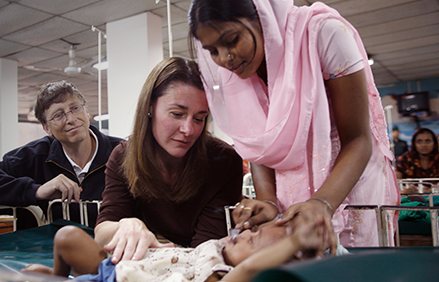Seattle, February 1st. Portlanders were on hand for the opening of the new Bill and…


By Melinda Gates: Like most women I know, I have used contraceptives for many years. I knew I wanted to work both before and after becoming a mom, so I delayed getting pregnant until Bill and I were sure we were ready to start our family. Twenty years later, we have three children, born almost exactly three years apart. None of that happened by accident.
The decision about whether and when to get pregnant was a decision that Bill and I made based on what was right for me and what was right for our family—and that’s something I feel lucky about. There are still over 225 million women around the world who don’t have access to the modern contraceptives they need to make these decisions for themselves.
In the decade and a half since Bill and I started our foundation, I’ve heard from women all over the world about how important contraceptives are to their ability to take charge of their futures. When women are able to plan their pregnancies around their goals for themselves and their families, they are also better able to finish their education, earn an income, and fully participate in their communities.
And not only do moms benefit; their kids benefit, too. In communities where women have access to contraceptives, children stay in school longer, and entire families are healthier, wealthier and far better equipped to break the cycle of poverty.
For all of these reasons, in 2012, I co-chaired a summit that brought leaders from around the world together around the goal of expanding expand access to contraceptives for the women who desperately want and need them. The global partnership, called Family Planning 2020, pledged to get 120 million more women access to contraceptives by the year 2020. It was an ambitious but achievable goal—and an important promise to women in the world’s poorest places that they will not be forgotten.
Unfortunately, our progress has not yet lived up to our ambition. We are now more than halfway to the 2020 deadline, but not yet on track to reach 120 million women by the promised date. As of the halfway point in July 2016, we had reached 24 million additional women with family planning services. Unless we begin making up for lost time, we will miss this chance to make this a turning point for women around the world.
When I think about what’s at stake over the next three years, I think about the lives of women like Anita and Sushila, both of whom I met last year in a village in India called Kamrawa.
Anita, who guesses she’s about 40 years old, lived most of her life without access to contraceptives. She got married when she was a teenager and became pregnant within a year of her wedding. The birth of her first child was followed by the birth of four more. None of these pregnancies were planned—because without contraceptives, planning her family simply wasn’t an option.
When I asked Anita what it was like to raise so many kids on such a limited income, she got sad and reflective. “I had a lot of problems,” she told me. She spent all of her time and energy looking after her family and trying to keep her household running—preparing food, tending to animals, keeping things clean in a house with no running water—leaving almost no time at all for her to do anything else, even get a job to help with expenses. It was a life of deprivation, hard work and endless worrying.
But things in Kamrawa have changed since Anita was a young mother. Now, contraceptives are widely available, and women have the chance to make the reproductive decisions that are right for themselves and their families. As a result, families are smaller, and parents are better able to afford nutritious food and school fees for all of their kids. The whole village is healthier and more prosperous.
Even though her children are grown, Anita is excited about what this means for the next generation. “I don’t want my daughter-in-law to go through the same problems,” she told me.
Another woman I met, Sushila, is a 28-year-old teacher who’s using contraceptives to plan her family and her future. She has two children—a five-year-old son and a two-year-old daughter—and loves being a mom. But Sushila and her husband are committed to limiting the size of their family so that they’re able to give each of their children the lives they deserve.
Sushila also told me that as soon as both her kids are in school, she plans to return to her job as a teacher. A generation ago, working moms were almost unheard of in villages like Kamrawa. But now that women have the option to plan their pregnancies, they have many other options, too.
When you think about the difference between Anita’s life and Sushila’s life, it’s clear that progress is possible. The question is whether we will commit the resources and mobilize the will to ensure that this progress extends to more women in more places.
In 2012, we made a promise to women around the world. Our actions over the next three years will decide whether we keep it.
For more information, here’s a link to Family Planning 2020: http://www.familyplanning2020.org/
Recent Posts
Portland Art Museum Exhibit Will Highlight Contemporary Art from the Collections of Jordan D. Schnitzer
Portland, OR. Opening in September 2025, the Portland Art Museum (PAM) presents Global Icons, Local Spotlight:…
VIPs Gearing up for Classic Wines Foundation Gala
Portland, OR. Organizers say the "Salon de Vin" benefit for Classic Wines is shaping up.…
Diamonds & Denim Gala Will Benefit The Links, Inc.
Portand, OR. The Portland Chapter of The Links, Incorporated, and the White Rose Educational Foundation…
Nonprofits Honored as Providence Health Plan Celebrates 40th Anniversary
Portland, OR. Providence Health Plan recently celebrated its 40th anniversary with a totally rad 1980’s…
Oregon Historical Society Hosts History Makers Gala
Portland, OR. The Oregon Historical Society’s (OHS) annual Oregon History Makers Awards & Dinner recognizes…
Lan Su Garden Kicks off November With Floral Design Competition
Portland, OR. Move over pumpkins, the Lan Su Chinese Garden is welcoming fall with its…


